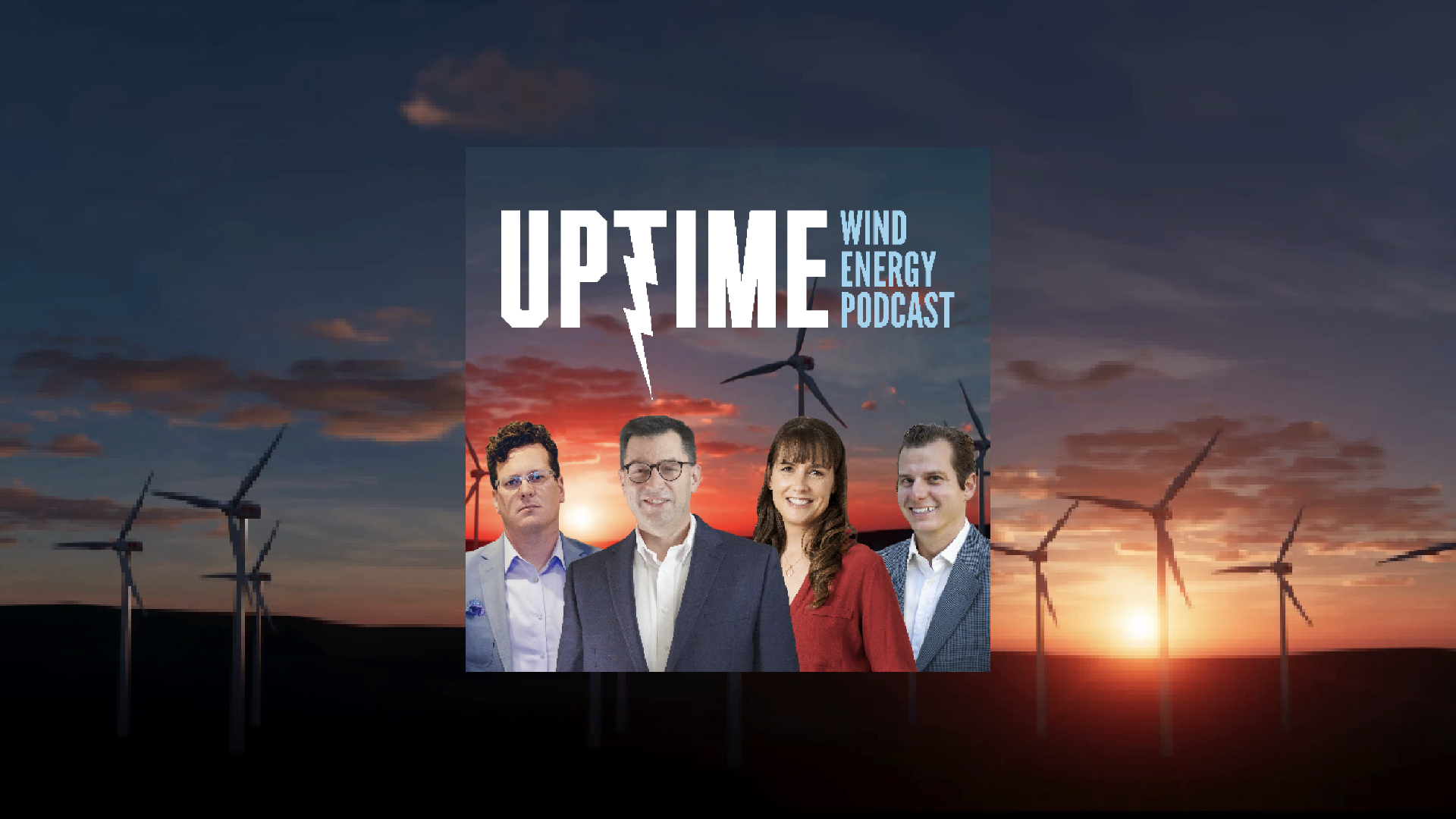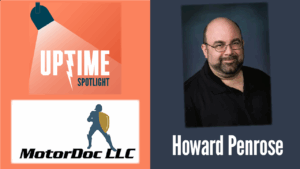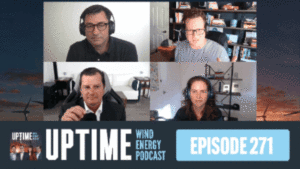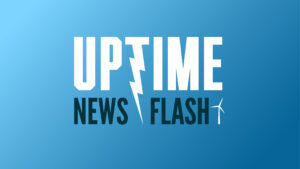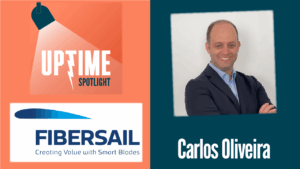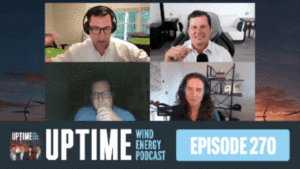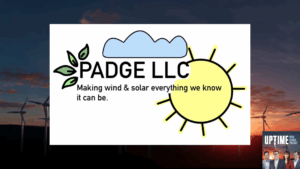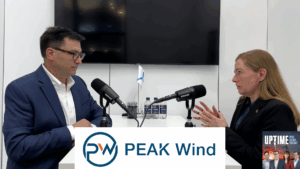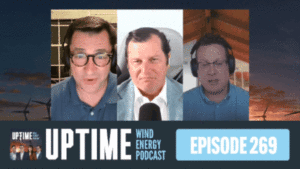Podcast: Play in new window | Download
In this episode, we discuss an offshore vessel collision in the North Sea, highlight Louisiana’s offshore wind ambitions, the latest developments in South Australia’s renewable energy expansion. Plus we highlight an article from Buoyant Works in PES Wind Magazine. Register for the upcoming SkySpecs’ webinar on turbine repair challenges!
Sign up now for Uptime Tech News, our weekly email update on all things wind technology. This episode is sponsored by Weather Guard Lightning Tech. Learn more about Weather Guard’s StrikeTape Wind Turbine LPS retrofit. Follow the show on Facebook, YouTube, Twitter, Linkedin and visit Weather Guard on the web. And subscribe to Rosemary Barnes’ YouTube channel here. Have a question we can answer on the show? Email us!
Allen Hall: On Wednesday, April 30th at 11:00 AM Eastern, get that on your calendar. SkySpecs, Uptime and PES Wind are hosting our next session of a 10 part series of wind related items on their webinar. So this time it’s gonna be about the the biggest challenges facing turbine repair teams today. And we’re gonna have four experts besides Joel and me.
I guess we don’t count as experts, Joel. So we’re gonna be talking to real experts. Sheryl Weinstein from Sky Specs, Alice Lyon from Lyon Technical Access. Craig Guthrie, who I’ve known forever from Takkion, and Jose Mejia Rodriguez from RNWBL. We’ll be there to, uh, explain how you should be planning for this repair season.
What are some of the approaches that the operators use and what works and what doesn’t work? Things that if you’re in the repair business or if you work. For a large, uh, operator or even a small operator you want to hear and participate in, there’ll be a q and a session. So get all your questions ready, but [00:01:00] you first have to register and you can register in the link and the show notes below.
Do not miss this event. April 30th, 11:00 AM Eastern. You won’t wanna miss it.
Speaker 2: You’re listening to the Uptime Wind Energy Podcast, brought to you by build turbines.com. Learn, train, and be a part of the Clean Energy Revolution. Visit build turbines.com today. Now here’s your hosts, Alan Hall, Joel Saxon, Phil Totaro, and Rosemary Barnes.
Allen Hall: Up in the Netherlands, three crew members were injured when an offshore support vessel struck a windman foundation. In the North Sea and the Royal Dutch Sea Rescue Society had to evacuate two of the injured crew members from the privately owned vessel. And a third uh, crew member went to get medical attention once they got back to port.
Now, this occurred about 15 miles from the Netherlands shores, and the Dutch have opened an [00:02:00] investigation, and my first responses to reading this news was. How are we driving ships into foundations still? And Joel, can you explain all the technology that is there to prevent you from doing this?
Joel Saxum: Well, every one of these vessels that operates in that environment is going to have a, a helm display, right?
That’s gonna have all of the things called stent and aids to navigation. So it’s gonna have all the buoys, everything in the water that you could possibly run into. Some of ’em even have detailed stuff like pipeline data and stuff so you don’t drop your anchors in certain places. But either way, they’re gonna ha they’re gonna have knowledge of this besides the fact that you can look out the window and see the tur, see a turbine that’s 500 feet tall in front of you.
That’s a different story maybe. Um, but a lot of these vessels too, of this size. So this is a, um, a support vessel offshore. So there’s all kinds of different classes of boats, things they do. But this thing may work in a wind farm. It may work for oil, uh, platforms, it may work for the fishing industries.
Like it can do a lot of different stuff. But as a, as a [00:03:00] emergency response. Uh, vehicle. They also should be DP one. And when I say DP one, that’s dynamic positioning. So that means that you should be able to have a button in the, in the vessel that says, boom, hold me here. And, uh, DP one means you just have one methodology of, of positioning.
So that’s like GPS. I’m at this GPS point. Hold me at this GPS point. Um, so there’s a lot of safety mechanisms built into these things, and there’s a chain of command and all these vessels. I think it said it was crude by eight people. Correct? Correct me if I’m wrong, Alan. That sounds about right. For a hundred, 150, 150 foot operating vessel, eight people’s.
About right now, everybody has their own job, right? There’s a captain, but there’s usually this, you know, a second mate and there’s other people on the vessel that someone at all times is looking forward or is supposed to be at least. Uh, but like Phil said earlier today, when we were kind of doing some podcast planning, if you saw the pictures of this thing in port, it looked like it ran square on into the turbine headfirst.
I
Allen Hall: think it was the, uh, [00:04:00] mechanical error or where an operator error just from the damaged photos. I think it’s
Joel Saxum: operator error. I think that’s someone not chain of command, not paying attention
Phil Totaro: somehow. Well, it’s just one of those, the, you know, unfortunate and frankly frustrating things that, and this is, I believe in the last five or six years, the.
Sixth vessel that’s run into something like a foundation under construction or an operating wind turbine or something out there. Um, I mean it’s happened in Germany and, and now. Here in, in Holland with the, with the Holland Coast, uh, three and four project is my understanding Vattenfall project out there, um, with the Siemens 11 megawatt turbines.
So it’s unfortunate that this keeps going down, but I don’t know what I mean. To Joel’s point, I don’t know what more. You could do with technology to warn you that something’s out there. ’cause in addition to everything that Joel mentioned, we [00:05:00] also know where the wind turbines are located. There’s, there’s geo coordinates for all the turbines in the wind farms and there’s theoretically some kind of geofencing around the wind farm that tells you, Hey, by the way, you’re entering this zone.
Which I mean, as an SOV, presumably you’re supposed to be kind of nearby, but. I just don’t like, I don’t know. I mean, this isn’t a technological problem to, to me this is, this keeps sounding like human error. What’s the next step?
Joel Saxum: Phil is the next step. We put like a, we put radar on the transition piece with like an audible alarm.
Like when something gets within 500 meters, it just goes. I don’t know what else you can do. I mean, they can’t see
Phil Totaro: him apparently, so they gotta hear him. Maybe. I don’t know. Well, to be clear too, I don’t think this was like, uh, you know, a situation where they had fog and or some other kind of obstructed vision.
It was a, to my understanding, it was a reasonably clear day. So I just don’t understand how that’s gotta be some level of human failure, how you [00:06:00] just smash into a thing that’s that big, uh, you know, right in front of you. It’s
Joel Saxum: like fog being one thing or like pours visibility. But I’m looking at the picture of this vessel and this vessel has.
A radar on it. It has its own radar, so it’s gonna pick it up on the screen next. So no matter what, you should have either been able to look out the window or look at the screen and see the thing in front of you, or look at the GPS coordinates of the, the, you know, problems
Phil Totaro: out there. So, I, I don’t know to, to answer Joel’s question, I don’t think we need more technology, uh, because even though you could, you know, avail yourself of, of radar on every vessel, I mean.
Those that gets expensive and somebody’s gotta pay for it. And guess who ends up paying for it? Is, you know, the vessel operator ups their contract. The, you know, project developer has to increase the overall cost of the project and then it takes them longer to, to. Get paid back with the the PPA and or CFDs or whatever other mechanism they have, [00:07:00] and we as electricity rate payers are the ones that end up paying for that at the end of the day.
So I don’t, you know, if this is something that can be solved without. Additional technology upgrades. I’m kind of all for that, but something needs to be done as far as like, Hey, there’s a big thing like, you know, a few hundred yards right in front of you. Try not to hit it. You know,
Allen Hall: speaking of not running into wind turbine foundations, there’s actually an article in PES win, and if you haven’t downloaded the latest addition of PES Wind, you can do that on your own@pswin.com.
You just type it into the old Google and. Push the button and there it is. Now, there’s a lot of great articles in this quarter’s edition and a good bit of offshore in it. The article I wanna highlight today is from Buoyant Works, and if you’ve been to the Buoyant Works website, you can see all this sort of the polyurethane bumpers that they have created for not only the.
The towers, but also the CTVs, which is really important because they [00:08:00] do run into one another once in a while and it has become more of an issue is that, uh, there’s damage on some of these vessels. And just trying to minimize the, the complexity of trying to get close to a turbine without damaging it is, is a huge problem.
And if you have read the article here, and I encourage you to do that on your own. There’s a lot going on, uh, as these CTVs approach these turbines and just trying to avoid damage and trying to keep from having bump incidences where the, the crew gets rocked is important here. And Joel, as you have pointed out many times, safety is of the utmost here, uh, on these crew transfer vehicles.
Joel Saxum: Yeah. If you haven’t been offshore, there’s something to understand, uh, in operations that maybe most people don’t. So if you’re seeing, like if you’re at a boat ramp at, at the, your local lake or river and you see a boat go back off a trailer, they usually kinda like throttle down and sit there and they’re waiting for people or whatever.
When you’re [00:09:00] in a marine environment, when you’re dealing with big vessels and you’re doing any kind of operations, whether it’s pile driving, rock lay, or whatever it may be. That vessel is almost always throttled up. You’re a, you’re at a certain amount of throttle all the time because that’s how you’re able to hold position.
So it’s the same thing when A CTV approaches a, a, a transition piece or a wind turbine, they nudge up against where the ladder is and there’s mechanisms designed there, engineering mechanisms, and that’s what. Uh, they do here at Buoyant. Uh, there’s their Buoyant works all of their different systems to make sure they slip, but they put that boat right against the transition piece and they throttle it up to hold it there.
So it’s nice and steady. But when you’re in the North Sea or somewhere offshore and you got two three meter heaves going on, you’ve gotta be able to. Efficiently slide up and down that transition piece while you’re throttled up. And that’s what their, uh, their systems allow people to do safely. ’cause if you’re not doing that safely, the boat starts to pinch and move and squeak and it get, get hung up or held.
You can’t have that, otherwise you can’t transfer. Um, [00:10:00] so these, uh, what, what you looking at here is, oh, this is cool offenders. No, they actually are the things that allow us to safely transfer people offshore.
Allen Hall: So check out the website, buoyant works.com. And take a look at their polyurethane products and accept no invitations.
Buoyant works.com.
Speaker 5: As busy wind energy professionals staying informed is crucial, and let’s face it difficult. That’s why the Uptime podcast recommends PES WIN Magazine. PES Wind offers a diverse range of in-depth articles and expert insights that dive into the most pressing issues facing our energy future.
Whether you’re an industry veteran or new to wind, PES Wind has the high quality content you need. Don’t miss out. Visit ps wind.com today.
Allen Hall: As part of our oil and gas, uh, oversight because I am really tired of reading about, oh, a wind turbine had a problem. Yeah. So does oil and gas, and you may not have read in your local newspaper about the spill they had in the [00:11:00] Keystone, Keystone Oil pipeline up in North Dakota, but it dumped about 140,000 gallons of crude oil on the ground.
They had a mechanical problem where one of the employees heard a. Boom, and then realize maybe we’re leaking a little bit of oil. Uh, this goes back to, uh, a couple of other incidences that have happened with pipelines, particularly this pipeline and that pipeline. Joel runs from, uh, essentially Alberta. Uh, kind of down across to Manitoba, I think it is, right up, which is right above North Dakota.
Then takes a right and goes, goes straight down through North Dakota, South Dakota into Nebraska, then heads over towards, uh, Illinois. So, you know, yikes. Transporting oil is not easy, not as easy as it’s claimed in the media at the moment.
Joel Saxum: Yeah, this time of the year is, uh, difficult for the northern latitudes as well.
So that area of North Dakota, a lot of organic [00:12:00] soil. This is a weird geo geotechnic conversation, but the reason that you have pipeline breaks this time of year is because the frost is coming outta the ground. So when, when those pipelines, when they get pressurized and they move things, they get a lot of, they get heat built up in ’em.
So you have a warm pipeline and then you have it running through soil that is half frozen, half not, and the ice is coming out so that soil starts to move and, and bend. So when they say, Hey, I had an employee that heard something, pop break, that’s because the soil itself is actually moving. Um, and you’ll know that if you’ve ever been up there driving on highways in the springtime, uh, we call it, we call it breakup season when everything starts moving.
But that’s what happened. Right? And it, and it is a, it’s a, it’s a really, I mean, it’s a black eye for, for the oil industry. Uh, but it happens more often than you think. Uh, pipeline breaks, whether it’s, whether it’s crude or whether it’s natural gas or, or whatever’s being pumped. Um, these are, these are rigid pipelines that are run across ground that moves.
So I think the, you know, your, your, your alternatives to [00:13:00] moving crude like that are either on a train or on a truck. And pipelines are safer than those. So this is the, the least of the, uh, the evils.
Allen Hall: Yeah. It’s still a problem. I, I, I am just really tired of hearing oil and gas representatives talk about how wonderful it is.
Like they don’t have any problems. They have problems and there’s a lot of problems, but we’ve, it’s become normalized. It’s, it’s back to Rosemary’s point from several months ago now, like when you have disasters all the time, it becomes normal. It’s okay. No one reports on it. It’s not, it’s not news anymore.
Joel Saxum: At a certain level, there’s like the nimbyism thing, right, where people get really bent outta shape about renewables because they can see it. You can see turbines everywhere, right? When they’re, when they’re up on the horizon, you can see ’em miles away. You don’t see pipelines. But I, I bet you, I don’t care which one of us I’m talking to, even here on the panel or whoever’s listening, within a mile of your house, there’s a pipeline somewhere.
Uh, yes. You just don’t see ’em. You don’t know. You don’t see ’em. So you don’t, it’s not, it’s not an issue until it’s an issue. Wind [00:14:00] turbines, solar panels, battery storage, all these different things. They’re very visible, so it’s easy to see. I encourage anybody who thinks that, that it wind is an eyesore to drive up to Midland, Texas.
And take a vacation out there and then, and then give me a call afterwards and tell me what you saw.
Allen Hall: And let’s go to a country where things are going in the right direction. In South Australia’s renewable energy sector, they are expanding, uh, with plans to what become the state’s largest wind farm and Tilt renewables has proposed.
The, and Rosemary, you’re gonna have to correct me on, on. The Australian pronunciation of this Nwi wind farm, which at the 1.2 gigawatts in 148 turbines, and included with this wind farm are two batteries. Storage systems that can offer up to 300 megawatts of capacity for eight hours of storage duration.
That is massive, Rosemary.
Rosemary Barnes: Yeah, it’s huge. And I think it also comes, um, like, uh, I believe that the intention is construction would begin in [00:15:00] 2029. Um, and so yeah, it would come online after 2030 when the state, I think already plans to be a hundred percent renewable, um, in its electricity, uh, generations. So that’s a really interesting point, like what are, yeah, what are tilts plans for this, uh, huge amount of clean energy once the state’s already at a hundred percent, um, clean.
So, uh, a clue might be in the location. It’s right next to Whyalla, which, um, Australians can’t help but be aware of because for some reason this small town is raised at every single election. There is some sort of publicity stunt involving Whyalla. Um, it’s a big steelworks community and yeah, it’s been used as a example, uh, from, from both sides of um.
The climate change debate about, yeah. Originally it was cited as an example of, this town will be wiped out if we, you know, choose to act on climate change. Um, yeah. ’cause they’re manufacturing steel and currently steel produces a lot of emissions. But then on the [00:16:00] flip side, I. Well, you know, there’s the potential for this to become green steel, given that there is such a huge renewable energy, um, potential in that region.
So that’s my, that’s my guess. Probably a pretty safe guess that there’s some, some sort of plans for industrial uses for this huge amount of green energy that would come online.
Joel Saxum: I think an interesting thing here too, in the article they’re mentioning 90 meter blades and, and I don’t know if they have a turbine model planned or they’re just expecting that’s what it’ll be, but because the port, the port of Al’s right there, they only have to transport those big old blades.
50 kilometers out to the site. Like that’s, that’s amazing. That’s great.
Rosemary Barnes: Yeah. I think they also cited that might come from port, port of Adelaide might be used for transport as well, so it’s a little, little bit further, but still not, not that far in, it’s not like a really lush, vegetated region with a whole lot of huge dense forest right up to the road.
It’s um, you know, it’s a fairly, um, arid, uh, [00:17:00] climate in that region, so I don’t think that transport is gonna be a huge, huge issue for them. Um, yeah, but I do think that also that’s, that’s all I hear for, um, for new big wind farms in Australia, all I hear is huge wind turbines like much bigger than what you typically see for, for onshore.
Like, I don’t, like six megawatts is kind of like. The smallest for things that are coming on very soon. And then after that, people are talking like 10, 12 megawatts. Like I, obviously these turbines barely exist now beyond, you know, like computer models and, um, maybe some prototypes, but obviously. They’re making really big offshore wind turbines.
It’s a lot easier to probably go in the direction from offshore to onshore than the other way around. So it’s not like anyone doubts that it’s possible to make wind turbines like that. Um, onshore wind turbines that big, but. The, um, logistics of installed them seems hard.
Joel Saxum: You know, Alan, correct me if I’m wrong, [00:18:00] but, but, uh, one of our friends down in Australia told us that GE was gonna be installing only one model, the 6 1 1 58, 6 0.1 megawatt machine from here going forward.
And I think, Rosemary, to your point, he also told us that this is the, one of the first turbines that they’ve extensively tested. For a longer duration. So this was the first one that’s been like the, the, you know, serial, serial number, number one has been installed and will have been running for a year before they even install serial number number two in the field.
So that’s a, so tackling both things here, bigger turbine. Yes. Uh, and that’s the only one they’re gonna go with. So they can focus on, it is a workhorse machine and they can make sure they’re maintaining it correctly, but they’ve also got some, uh, they’re gonna have more operational history on it before they actually go and start.
Building tons of’em. ’cause we know we’ve heard of those wind farms where they, the turbines don’t even have a tech certificate yet and they’re sending a two, 300 of ’em out there.
Rosemary Barnes: Yeah, well, I mean it’s really [00:19:00] normal that you know, like your, um, and you know, obviously I know, I know blades primarily, but you know, your serial number one is your test blade.
Maybe there’s a two as well. That’s also a test played sometimes. Not usually. Um, and then, yeah, like, so serial one is a test blade. Serial number two is in the field, and so is 3, 4, 5, 6, you, you know what I mean? Like you start the test. You’ve probably passed like some, some of your tests, maybe the, um, static test is completed already, but then the fatigue test is only partway done by the time that you’re installing, um, blades in the field usually.
So, I mean, it’s, it’s because people have become very good, um, the design codes, the, you know, the materials factors that they. They know it all really well. It’s really proven out over decades of experience, and so they felt very safe and it was incredibly rare that you would see a problem until recently.
Now it’s not such a big problem. So I think that’s a, a fantastic, um, step to make, to be a bit more certain. But I mean, [00:20:00] even that is not I adding. All that much safety, if you think about it, one turbine in one location in the world. I thought what you were gonna say is that GE are only doing one turbine type in Australia and that they have taken the effort to understand that Australia’s specific conditions and, uh, you know, know that the.
Leading edge protection is UV resistant and so will last more than one year. That Yeah. The, you know, lightning protection system performs well under the types of storms that we see in, uh, the places in Australia where they install a lot of, um, big wind farms. Um, that, yeah, like there’s some, uh, higher temperature resistance because you know, a lot of, um.
A lot of wind farms are in deserts where the temperatures are frequently above 40 degrees during the day. And everyone knows, everyone that’s been in a wind turbine knows that inside the wind turbine, inside the blade is at least 10 degrees hotter than that, right? Pushing up, butting up or past, um, material safety limits.
So, um, that is what I would, I [00:21:00] would really like to see.
Allen Hall: Don’t let blade damage catch you off guard the logics. Ping sensors detect issues before they become expensive, time consuming problems. From ice buildup and lightning strikes to pitch misalignment in internal blade cracks. OGs Ping has you covered The cutting edge sensors are easy to install, giving you the power to stop damage before it’s too late.
Visit OGs ping.com and take control of your turbine’s health today. Yeah, the classic cultures, a delegation from Louisiana traveled to Denmark to learn about, uh, wind energy from the experts in Denmark, which is a smart thing to do, and I wish more states would do this actually. Uh, the tour, which is organized by the center for.
Planning excellence included state and local officials from Louisiana, academic researchers, industry experts, and of course port authorities, which are so critical to the success of offshore wind farms. And they went over to, uh, learn all they could from [00:22:00] everybody in Denmark. Now, the, the ports in Denmark are really unique in the sense that they have been redeveloped over time and they are.
Are extremely powerful in supporting denmark’s wind energy, uh, organizations. And they support a lot of ’em, uh, right from the ports in Denmark. Now, one of the things I thought was a little interesting is that Louisiana, which really doesn’t have any offshore wind, is actively pursuing it. And even though the, the, the, the federal government in the United States is not looking to announce any more win sites, Louisiana, I think it’s going to push for some.
Because it does provide a number of jobs, and Louisiana is really set up and our friends at Gulf Wind Technology have created a low wind speed wind turbine blade that will make it possible to have offshore wind near Louisiana. Joel, does this make sense to you? Does it seem like Louisiana has taken a very forward first step?
Joel Saxum: I think there’s a couple of ab, absolutely, completely agree. Alan, I’ll just [00:23:00] start with that, but there’s a couple of things here Louisiana Wise that people may not know. First one. When they started developing offshore oil and gas in the North Sea and Norway and all this stuff, and back in the seventies, they called people from Louisiana to come and teach ’em how to do it.
’cause the, ’cause the, the Cajun Navy had been doing it in, in the Gulf for a couple years already. So they knew how to do it. They took their expertise and they went and gave it to. The North Sea, right? So now the tides have turned, the louisianans are heading back up to there, to, to the North Sea to get some knowledge to bring it back.
And uh, so that’s one little kind of equipped story. But the other one that’s interesting here too, and Phil, you and I have talked about this. I know Alan, we’ve talked about this as well. Louisiana’s the only state that has tried to do offshore wind within their state boundary waters. And they’ve put in.
They put in legislation to share in the profitability of these wind farms, which is a great move in, in, [00:24:00] in my opinion, the same thing that like Alaska has done and Texas has done with their oil reserves. If the, is the reserves there, someone’s gonna make money on it, the whole state should benefit. So they’ve done that.
Um. They’ve got the infrastructure, like you said, Gulf Wind Technology. They got a key side facility. There’s all kinds of ship manufacturers. The ship, the Eco Edison, that’s up in or on Ted’s sites up in New York that came, that was built in Louisiana. So like the, I think that was, was Thatwe who built that one?
Maybe Phil, you know that, was that Edison SCH West? Yes. Yes. So I think they’re based in Houma, which is, you know, right there. So. They have the key side facilities. They have the vessels. They know how to operate offshore. They’ve already put legislation in place. I think that the, the government of Louisiana is, is charging forward.
I did read something the other day too that said, um, quietly there has been some onshore development in Louisiana. They’re like fi five different wind farms that have been then property rights and those kind of negotiations are going on in the background that. The general, you [00:25:00] know, the general wind industry.
You wouldn’t think of Louisiana as a place for wind, but it’s happening.
Allen Hall: Well, let’s talk about, the one item I wanted to talk about, about this is the food culture and the clash between the two food cultures. So having been to Denmark and Rosemary took, uh, Valerie, my wife and me to a, uh, really nice, uh, restaurant with where they have SMI board gr, which is this open face sandwich on rye bread.
That is about the consistency of a two by four Delicious, but it is very thick and dense. So, uh, you have to, you have to, it isn’t the same what you’re gonna pick up and eat. You’re gonna have to cut it with a knife and a fork. It’s really thick. Delicious, though. Quite delicious. And Louisiana is known for the Cajun cooking, right?
Everything New Orleans is fantastic. I did a quick look to see how many Michelin stars are in the state of Louisiana and Louisiana’s about. Three times the size of Denmark. There are no Michelin restaurants in the state of Louisiana, which is hard to believe. ’cause if you’ve been to New Orleans, [00:26:00] they have a lot of great restaurants.
Rosemary Barnes: It has a reputation for good food too. It’s not like the rest of the world is, is knows that there’s good food there
Allen Hall: everywhere and where you stop. But Denmark has over 30 Michelin star restaurants.
Joel Saxum: Copenhagen has the most. The most of any city in the world. Copenhagen is the, the head.
Rosemary Barnes: Yeah, Denmark’s really good for, um, like it’s expensive to eat out, even like bad food is really expensive.
If you wanted to, I dunno, I never ate McDonald’s in Denmark, but, you know, something like that or around that level, like pizza, very expensive, not very good, but one step above that is not. Very much more expensive, but is like amazing quality. So if you go to like the local inns, they’re called Crow. Um, they, uh, usually like bordering with fine dining.
They’re just, the food is amazing. Like it’s a little bit more relaxed atmosphere, but just absolutely fantastic food. And in fact, one time we went to a place that was because we were living in Colding. It’s a town of like 60,000 people, like in. Fairly [00:27:00] rural jet land. We went to a place in a, a nearby, even smaller town, um, and went to this restaurant.
Fantastic. Like I’ve never had such good bread and butter was like the thing that stands out. Most of that meal for me was how good the. The bread and yeah, the bread and butter is, um, and then like a month later, it got a Michelin star, but it wasn’t, it wasn’t like it was known as a good restaurant, but it wasn’t like no one is being fine dining or anything.
But that’s like, that’s what I’m saying is that there’s a lot, like the bulk of the nice ish restaurants in Denmark are right on that cusp of being fine dining. Um, so it’s, yeah, it’s a little, it, it, it’s, it’s quite cool once you get the hang of it. And once you realize that. The lower tier, just no point doing that.
You know, you either stay at home and eat, or you spend a tiny bit more and get amazing food, but don’t do that like, you know, don’t go out for pizza. It’s, um, it’s hard to find, find something good like that.
Joel Saxum: I think, Rosemary, you nailed it. When we were talking earlier about premium ingredients, and that’s one of the big [00:28:00] differences between Denmark Food and Copenhagen Restaurants and Louisiana, because in Louisiana you may eat something and it tastes delicious, but you’ll have no idea what is in that food.
You, you, you’re gonna know that the base is probably a ro or they use the holy trinity at some point in this dish. Bell pepper, onion, celery, that’s the holy trinity in Louisiana. And most all dishes are gonna have some form of that in it. So you might be eating like a soup or like, sometimes it looks like a paste.
I don’t know, but like a good tufe. Is it lump crab? Is it crawfish? Is it what’s in here? I don’t know. Here you go. But it’s delicious. It’s gonna be good.
Allen Hall: Roseberry, you have a very important announcement.
Rosemary Barnes: Yeah. Uh, coming up we have uh, Australian Wind Industry Forum, which is on Tuesday, May 6th. And I’m very excited ’cause I’m speaking this year.
I have, um, I have tried to speak at this conference for a few years and it’s gonna be in a session. There’s a session on turbine design. [00:29:00] Um. Related issues, uh, turbine design and technology. And so I’m gonna be giving a presentation. It’s called. Innovation in wind energy lessons from the front lines. So I’m gonna be talking about how the design certification process works for wind turbines and then also what happens when something goes wrong.
You know, when you, uh, are in the field and you have, uh, I don’t know, serial defects or you suspect serial defects, you’ve got a lot of blades breaking. You’ve got a lot of. Lightning damage. You’ve got, I dunno, problems with, uh, excessive downtime for whatever reason. Um, yeah, gonna talk about that. And then also, like I mentioned earlier in the show, Australians really love to be the first ones to get a new type of turbine.
Um, how could you make sure that you can be a leader without being a Guinea pig? So gonna talk about some of the things you can do because actually, um, you, a customer, an an early customer, if they’re a large customer, does have the opportunity to be part of that design process. And in particular. You can request [00:30:00] certain tests are, are, are done.
Um, I’m not saying that it’s guaranteed that the OEM will perform them for you, but you certainly, you and your bank and your insurance all have the ability to, you know, be part of that, um, design process if you are an, an early adopter with a large order. So we’re gonna be talking about yeah. How to, how to manage all of those issues in the Australian context.
So come along
Allen Hall: and where can I go to register for this event,
Rosemary Barnes: you can go to wind industry forum.com au.
Allen Hall: That’s gonna do it for this week’s Uptime Wind Energy podcast. Give thanks for listening. Please give us a five star rating and tell your friends. Tell your neighbors. Tell your neighbors friends to start listening to the show.
We’ve had a lot more people join us lately. And we want that trend to continue. So thank you for listening, and we’ll see you here next week on the Uptime Wind Energy [00:31:00] Podcast.



